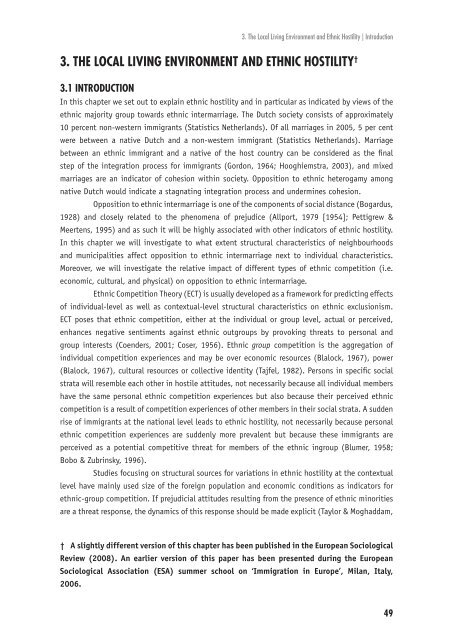Ethnic Hostility among Ethnic Majority and Minority Groups
Ethnic Hostility among Ethnic Majority and Minority Groups
Ethnic Hostility among Ethnic Majority and Minority Groups
You also want an ePaper? Increase the reach of your titles
YUMPU automatically turns print PDFs into web optimized ePapers that Google loves.
3. THE LOCAL LIVING ENVIRONMENT AND ETHNIC HOSTILITY †<br />
3.1 INTRODUCTION<br />
3. The Local Living Environment <strong>and</strong> <strong>Ethnic</strong> <strong>Hostility</strong> | Introduction<br />
In this chapter we set out to explain ethnic hostility <strong>and</strong> in particular as indicated by views of the<br />
ethnic majority group towards ethnic intermarriage. The Dutch society consists of approximately<br />
10 percent non-western immigrants (Statistics Netherl<strong>and</strong>s). Of all marriages in 2005, 5 per cent<br />
were between a native Dutch <strong>and</strong> a non-western immigrant (Statistics Netherl<strong>and</strong>s). Marriage<br />
between an ethnic immigrant <strong>and</strong> a native of the host country can be considered as the fi nal<br />
step of the integration process for immigrants (Gordon, 1964; Hooghiemstra, 2003), <strong>and</strong> mixed<br />
marriages are an indicator of cohesion within society. Opposition to ethnic heterogamy <strong>among</strong><br />
native Dutch would indicate a stagnating integration process <strong>and</strong> undermines cohesion.<br />
Opposition to ethnic intermarriage is one of the components of social distance (Bogardus,<br />
1928) <strong>and</strong> closely related to the phenomena of prejudice (Allport, 1979 [1954]; Pettigrew &<br />
Meertens, 1995) <strong>and</strong> as such it will be highly associated with other indicators of ethnic hostility.<br />
In this chapter we will investigate to what extent structural characteristics of neighbourhoods<br />
<strong>and</strong> municipalities affect opposition to ethnic intermarriage next to individual characteristics.<br />
Moreover, we will investigate the relative impact of different types of ethnic competition (i.e.<br />
economic, cultural, <strong>and</strong> physical) on opposition to ethnic intermarriage.<br />
<strong>Ethnic</strong> Competition Theory (ECT) is usually developed as a framework for predicting effects<br />
of individual-level as well as contextual-level structural characteristics on ethnic exclusionism.<br />
ECT poses that ethnic competition, either at the individual or group level, actual or perceived,<br />
enhances negative sentiments against ethnic outgroups by provoking threats to personal <strong>and</strong><br />
group interests (Coenders, 2001; Coser, 1956). <strong>Ethnic</strong> group competition is the aggregation of<br />
individual competition experiences <strong>and</strong> may be over economic resources (Blalock, 1967), power<br />
(Blalock, 1967), cultural resources or collective identity (Tajfel, 1982). Persons in specifi c social<br />
strata will resemble each other in hostile attitudes, not necessarily because all individual members<br />
have the same personal ethnic competition experiences but also because their perceived ethnic<br />
competition is a result of competition experiences of other members in their social strata. A sudden<br />
rise of immigrants at the national level leads to ethnic hostility, not necessarily because personal<br />
ethnic competition experiences are suddenly more prevalent but because these immigrants are<br />
perceived as a potential competitive threat for members of the ethnic ingroup (Blumer, 1958;<br />
Bobo & Zubrinsky, 1996).<br />
Studies focusing on structural sources for variations in ethnic hostility at the contextual<br />
level have mainly used size of the foreign population <strong>and</strong> economic conditions as indicators for<br />
ethnic-group competition. If prejudicial attitudes resulting from the presence of ethnic minorities<br />
are a threat response, the dynamics of this response should be made explicit (Taylor & Moghaddam,<br />
† A slightly different version of this chapter has been published in the European Sociological<br />
Review (2008). An earlier version of this paper has been presented during the European<br />
Sociological Association (ESA) summer school on ‘Immigration in Europe’, Milan, Italy,<br />
2006.<br />
49












